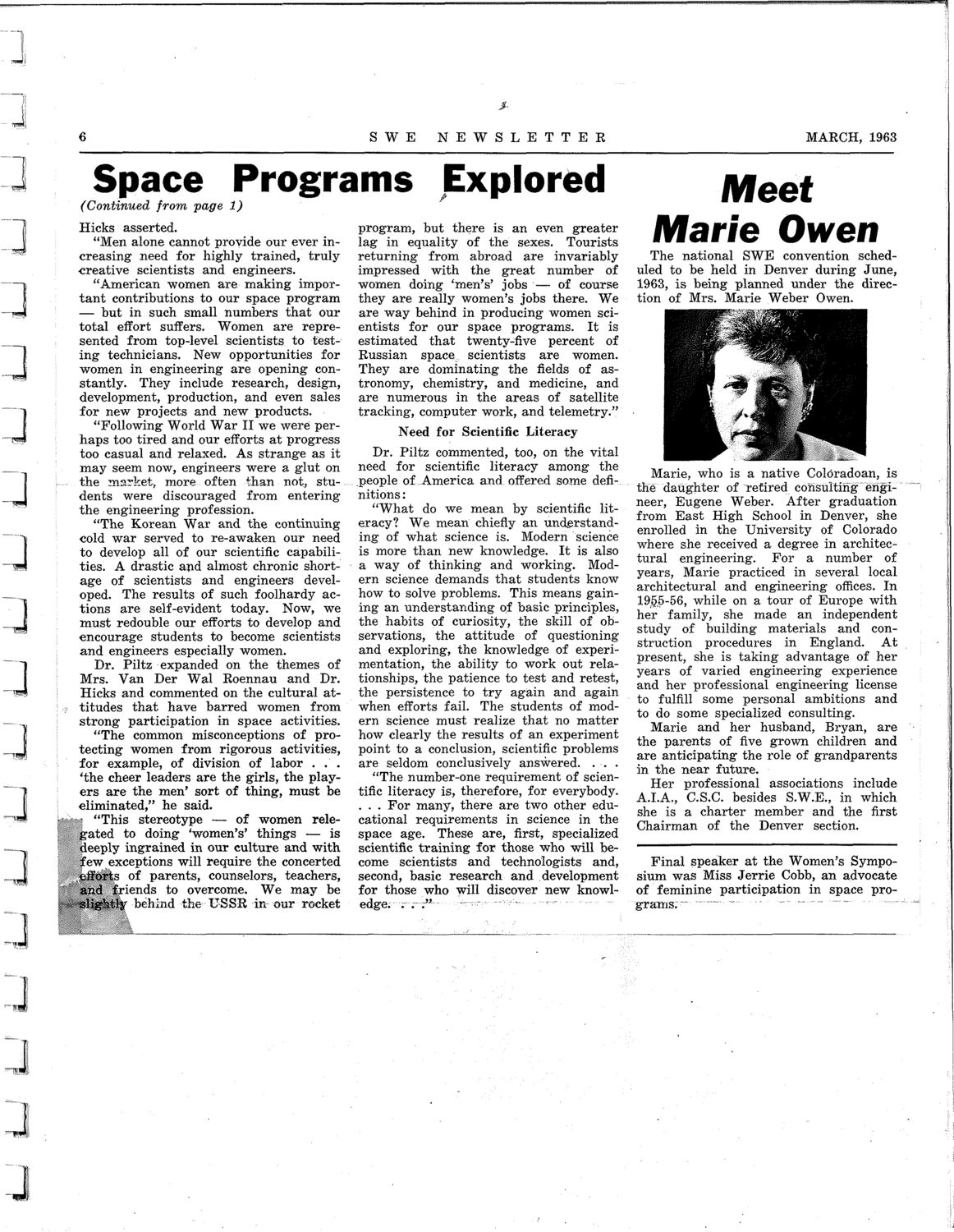| |
| |
Caption: SWE - News Clippings Book
This is a reduced-resolution page image for fast online browsing.

EXTRACTED TEXT FROM PAGE:
SWE N E W S L E T T E R MARCH, 1963 Space Programs Explored (Continued from page 1) Hicks asserted. "Men alone cannot provide our ever increasing need for highly trained, truly creative scientists and engineers. "American women are making important contributions to our space program — but in such small numbers that our total effort suffers. Women are represented from top-level scientists to testing technicians. New opportunities for women in engineering are opening constantly. They include research, design, development, production, and even sales for new projects and new products. "Following World War II we were perhaps too tired and our efforts at progress too casual and relaxed. As strange as it may seem now, engineers were a glut on the market, more often than not,, students were discouraged from entering the engineering profession. "The Korean War and the continuing cold war served to re-awaken our need to develop all of our scientific capabilities. A drastic and almost chronic shortage of scientists and engineers developed. The results of such foolhardy actions are self-evident today. Now, we must redouble our efforts to develop and encourage students to become scientists and engineers especially women. Dr. Piltz expanded on the themes of Mrs. Van Der Wal Roennau and Dr. Hicks and commented on the cultural attitudes that have barred women from strong participation in space activities. "The common misconceptions of protecting women from rigorous activities, for example, of division of labor . . . 'the cheer leaders are the girls, the players are the men' sort of thing, must be eliminated," he said. "This stereotype — of women relegated to doing 'women's' things — is di-eply ingrained in our culture and with few exceptions will require the concerted fali'orts of parents, counselors, teachers, and friends to overcome. We may be slight!) behind the USSR in-our rocket program, but there is an even greater lag in equality of the sexes. Tourists returning from abroad are invariably impressed with the great number of women doing 'men's' jobs — of course they are really women's jobs there. We are way behind in producing women scientists for our space programs. It is estimated that twenty-five percent of Russian space, scientists are women. They are dominating the fields of astronomy, chemistry, and medicine, and are numerous in the areas of satellite tracking, computer work, and telemetry." Need for Scientific Literacy Dr. Piltz commented, too, on the vital need for scientific literacy among the people of America and offered some definitions : "What do we mean by scientific literacy? We mean chiefly an understanding of what science is. Modern science is more than new knowledge. It is also a way of thinking and working. Modern science demands that students know how to solve problems. This means gaining an understanding of basic principles, the habits of curiosity, the skill of observations, the attitude of questioning and exploring, the knowledge of experimentation, the ability to work out relationships, the patience to test and retest, the persistence to try again and again when efforts fail. The students of modern science must realize that no matter how clearly the results of an experiment point to a conclusion, scientific problems are seldom conclusively answered. . . . "The number-one requirement of scientific literacy is, therefore, for everybody. . . . For many, there are two other educational requirements in science in the space age. These are, first, specialized scientific training for those who will become scientists and technologists and, second, basic research and development for those who will discover new knowledge. .- .--" „.,,r:. -•.•..:„. _..,., Meet Marie Owen The national SWE convention scheduled to be held in Denver during June, 1963, is being planned under the direction of Mrs. Marie Weber Owen. Marie, who is a native Coloradoan, is the daughter of retired consulting engineer, Eugene Weber. After graduation from East High School in Denver, she enrolled in the University of Colorado where she received a degree in architectural engineering. For a number of years, Marie practiced in several local architectural and engineering offices. In 19§5-56, while on a tour of Europe with her family, she made an independent study of building materials and construction procedures in England. At present, she is taking advantage of her years of varied engineering experience and her professional engineering license to fulfill some personal ambitions and to do some specialized consulting. Marie and her husband, Bryan, are the parents of five grown children and are anticipating the role of grandparents in the near future. Her professional associations include A.I.A., C.S.C. besides S.W.E., in which she is a charter member and the first Chairman of the Denver section. Final speaker at the Women's Symposium was Miss Jerrie Cobb, an advocate of feminine participation in space programs;^ -~
| |